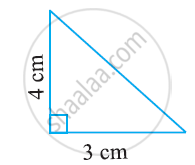Advertisements
Advertisements
Question
Prove that the points (2,3), (-4, -6) and (1, 3/2) do not form a triangle.
Solution
The distance d between two points `(x_1,y_1)` and `(x_2,y_2)` is given by the formula
`d = sqrt((x_1 - x_2)^2 + (y_1 - y_2)^2)`
In any triangle the sum of lengths of any two sides need to be greater than the third side.
Here the three points are A(2, 3), B(-4, -6) and C(1, 3/2)
Let us now find out the lengths of all the three sides of the given triangle.
`AB = sqrt((2 + 4)^2 + (3 + 6)^2)`
`= sqrt((6)^2 + (9)^2)`
`= sqrt(36 + 81)`
`AB = sqrt(117)`
`BC = sqrt((-4 -1)^2 + (-6 - 3/2)^2)`
`= sqrt((-5)^2 + ((-15)/2)^2)`
`= sqrt(25 + 225/4)`
`BC = sqrt(81.24)`
`AC = sqrt((2 - 1)^2 + (3 - 3/2)^2)`
` = sqrt((1)^2 + (3/2)^2)`
`= sqrt(1 + 9/4)`
`AC = sqrt(3.25)`
Here we see that, BC + AC not greater than AB
This is in violation of the basic property of any triangle to exist. Therefore these points cannot give rise to a triangle.
Hence we have proved that the given three points do not form a triangle.
APPEARS IN
RELATED QUESTIONS
For what value of k are the points (k, 2 – 2k), (–k + 1, 2k) and (–4 – k, 6 – 2k) are collinear ?
Find the area of the following triangle:

Prove that the points (a, 0), (0, b) and (1, 1) are collinear if `1/a+1/b=1`
Show that the points O(0,0), A`( 3,sqrt(3)) and B (3,-sqrt(3))` are the vertices of an equilateral triangle. Find the area of this triangle.
Show that the points A (3,1) , B (0,-2) , C(1,1) and D (4,4) are the vertices of parallelogram ABCD.
Find the area of ΔABC with A(1, -4) and midpoints of sides through A being (2, -1) and (0, -1).
If the points A (x, y), B (3, 6) and C (−3, 4) are collinear, show that x − 3y + 15 = 0.
If the points A(1, 2), O(0, 0) and C(a, b) are collinear, then ______.
The base and the corresponding altitude of a parallelogram are 10 cm and 3.5 cm, respectively. The area of the parallelogram is 30 cm2.
Find the cost of laying grass in a triangular field of sides 50 m, 65 m and 65 m at the rate of Rs 7 per m2.
